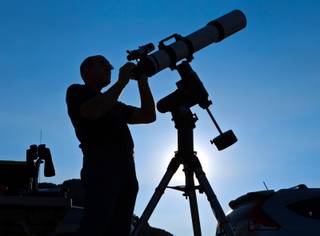
Las Vegas Astronomical Society member Rob Lambert holds the simulated sun as member Julian Shull displays the orbit of the earth and moon to Boy Scouts at their camp on Mt. Potosi on Tuesday, June 23, 2015.
Sunday, Oct. 18, 2015 | 2 a.m.
Jim Gianoulakis was 8 years old the first time he touched a telescope. On a summer night, his mother drove him and his sister to the massive Griffith Observatory overlooking Los Angeles, hoping to give her children a memory they would not forget.
Gianoulakis walked over to a telescope and peered in. Sandy, beige-colored Saturn hovered, its rings pronounced against the clear night sky. It looked so real, Gianoulakis thought it was as though a sticker had been plastered onto the eyepiece.
“Wow, wow,” he kept whispering to his mother.
To this day, Gianoulakis remembers that moment.
“There was something in the sky that I couldn’t see with just my eyes,” he says. “The way it presents itself in the telescope, it’s like, ‘Is this real?’ I was hooked.”
Gianoulakis, now 60, is a longtime member of the Las Vegas Astronomical Society, a 35-year-old club that includes about 100 amateur astronomers. Their goal: to make the public more aware of the wonders of the night sky.
Every month, the society has free stargazing parties at several locations, including Red Rock Canyon Visitor Center. The events have attracted a sizable following. When the astronomers invited the public last year to the Neon Museum, about 1,300 people came.
“In our everyday lives, we don’t realize what’s up there,” society member Keith Caceres said. “You broaden minds by showing our place in this world.”
The society recently embraced a new mission: fostering an interest in astronomy in the next generation.
After receiving a high-end telescope as a donation from a North Carolina amateur astronomer, society members discovered they had nowhere to put it. The telescope, which has the same optical design as the Hubble Space Telescope, is worth about $40,000.
So club president Rob Lambert struck a deal with the Las Vegas chapter of the Boy Scouts of America: Members of the Astronomical Society would get to use some of the Boy Scouts’ land at Mount Potosi, about an hour southwest of the Strip, if the astronomers would teach the boys about stars, galaxies, planets and moons.
The astronomers didn’t have to think twice.
“We don’t have a club large enough with the money to purchase a piece of land where we can put an observatory,” Lambert said.
And Patrick Ballinger, the Boy Scouts’ summer camp director, was more than happy to work with the astronomers.
“I wanted these guys to put passion for astronomy into these Scouts,” Ballinger said. “Let’s say out of these 80 kids who are here, a quarter of these kids become interested. They may be teaching the next Scouts.”
Surrounded by dry brush and blue skies at the top of Mount Potosi, Lambert and Caceres start the ritual of setting up their telescopes. They work half the time in intense silence, gingerly placing their stands and scopes on a tabletop and wiping off specks of dust that land on the aperture and eyepiece. After an hour of lifting, twisting and adjusting, the job is done.
They have about two hours before the Boy Scouts arrive, enough time to gibber among themselves and with other society members about who gets to point his telescope at which celestial object.
“I got Pluto,” Lambert said.
“I have Saturn,” Caceres said.
Behind the astronomers stands their donated telescope, shielded by a white dome that resembles a metal igloo. With its high-quality optics and precisely ground mirrors, the device can capture high-definition photographs of celestial objects, which society members would like to make available to the Clark County School District. They also hope to connect the telescope to a live stream that students can view online in classrooms.
“I don’t know if we will turn out the next Carl Sagan, but I don’t think that’s the important part,” Gianoulakis said. “If we attract a kid’s curiosity and develop in them the desire to explore, I think that’s something that will serve them well.”
It’s 8 p.m. Although the light of the Strip remains visible over the mountaintops, the sky is dark enough for the stars to dazzle. In the distance, screams and giggles from Scouts can be heard.
“Here they come,” Lambert whispers.
An hour later, the astronomers are overwhelmed by about 80 Scouts, hassling one another for a chance to peer into a telescope.
“Look at this one!” one yells. “Whoa, guys, look!” follows another.
One boy peers into Caceres’ telescope and beckons for his friend.
“You can see the rings of Saturn!” the boy screams in delight. “It’s soooo cool. It’s all real! It’s not a picture.”
Julie Ann Formoso can be reached at 702-948-7836 or [email protected]. Follow Julie Ann on Twitter at twitter.com/Julieannformoso.


Join the Discussion:
Check this out for a full explanation of our conversion to the LiveFyre commenting system and instructions on how to sign up for an account.
Full comments policy